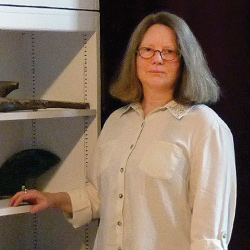Demystifying the world through art
Meredith Morten ’72 pursues passion across borders

“The arts are a basic element of a society,” Morten says. “They are a form of communication distinct from language; they weave the fabric of a culture. They serve as a bridge that can bring peoples and cultures together.”
And it’s that bridge that Morten, now a sculptor herself, wants to keep crossing, so much so that she was recently selected by the Fulbright Scholars Program to receive the Austrian-Hungarian Joint Research Award. This marks the second Fulbright Scholar Research grant in Morten’s professional life, the first being in 2009 to study Copper and Bronze Age cultures from the Carpathian Basin.
For four months beginning in February 2016, Morten will study Late Bronze and Early Iron Age artifacts in Austria and Hungary, focusing specifically on contemporary interpretations of prehistoric artifacts from the Austro-Hungarian Monarchy.
“Hungary continues to be a treasure trove of raw material for me,” Morten says. “Because contemporary borders do not geographically define prehistoric cultures, I explore artifacts in collections of neighboring countries as well. I find the designs and forms to be beautiful. The craftsmen also fascinate me — who were they? I feel a connection and strive to understand the commonality that links us and flows through time.”
While in Hungary, Morten will be hosted by the International Ceramics Studio (ICS), a leading facility for the silicate arts and artist residency. The stay will be her fourth at the ICS, which provides an environment she describes as a “cloistered enclosure where respect for work and concentration are honored and cultural exchange encouraged.”
In Austria, Morten will be hosted by the Department of Prehistoric and Historic Archeology at the University of Vienna. During her time, she will study, document and sketch objects and designs that inspire her before moving into the drawing and model-making phases.
Currently a professor of art at Montserrat College of Art, the Boston-based artist believes strongly that global engagement in the arts community benefits her work.
“Working among artists from other countries is very rewarding,” she says. “The opportunities to learn are exponentially increased by the diversity of backgrounds and experience of the participants. My understanding of processes and techniques deepens as I gain knowledge of cultures and peoples unfamiliar to me.”
As for her own approach to her creative process, Morten explains that it’s a state-of-being without emotion for her.
“Yes, I can get frustrated if something doesn’t go right or be pleased with a fortuitous result, but that is not what I consider to be at the core of my process. I am driven by a need to create,” Morten says.
Being deeply connected in a global society is also a driving force.
“The pleasure I derive from being in a global community is a byproduct of my wanting to be part of something larger than myself,” she says. “It is perhaps the desire to be more present or mindful, and directly experience that part of humanity.”